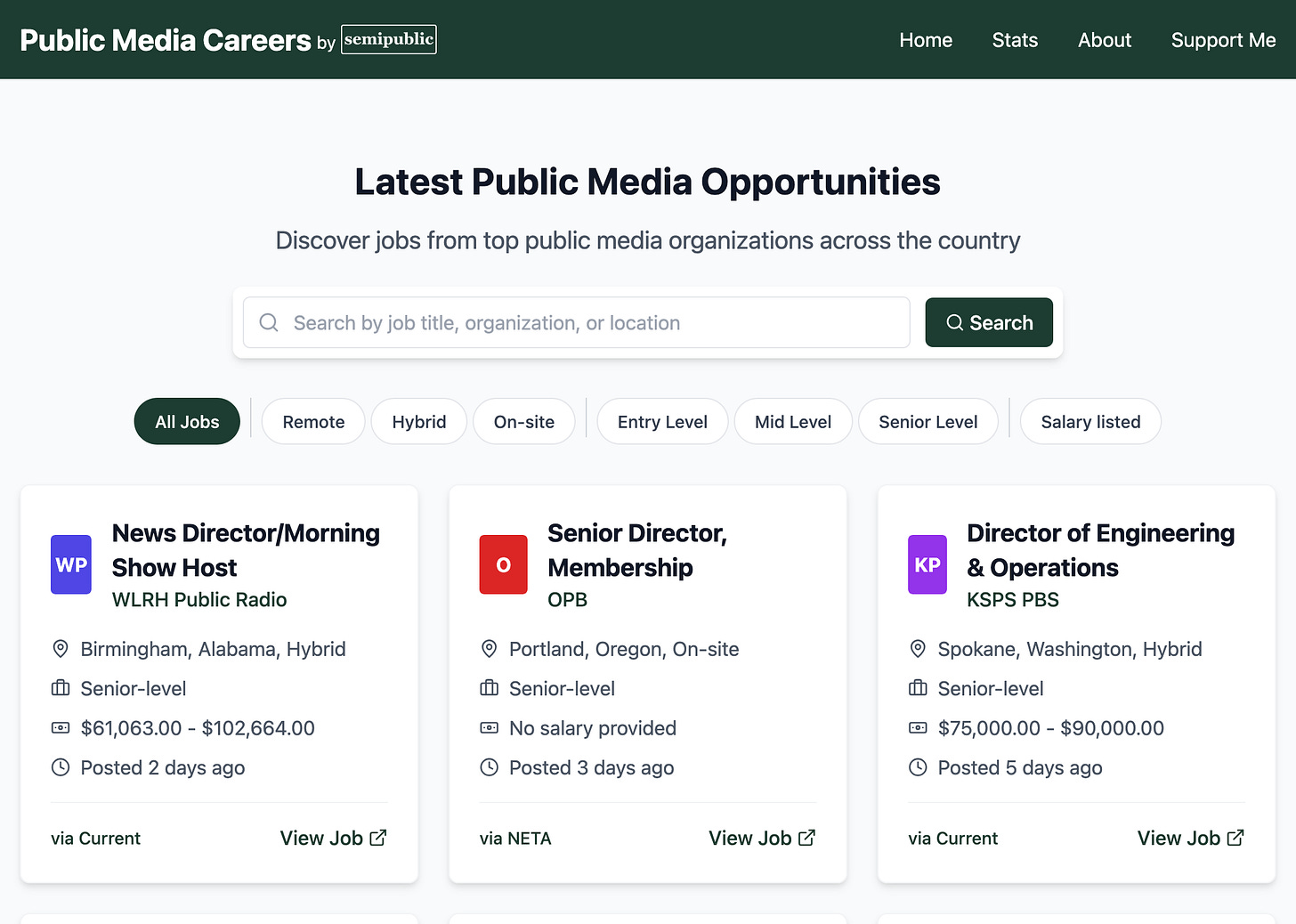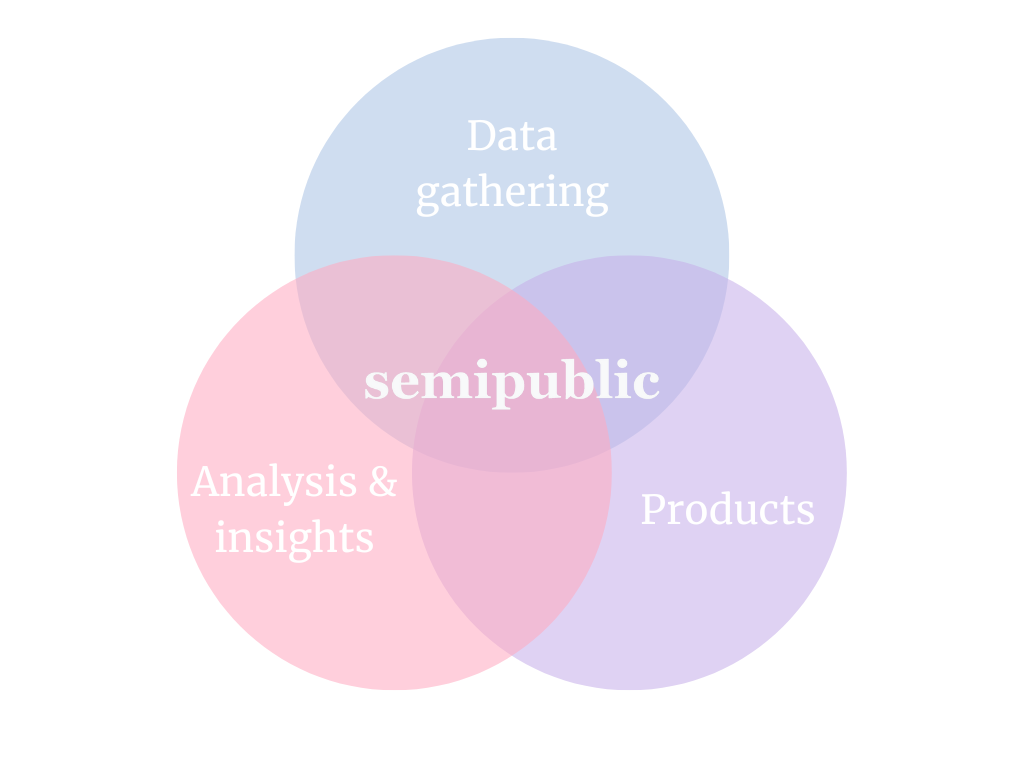Introducing a New Jobs Website for Public Media
jobs.semipublic.co aggregates listings from public media job boards across the web into one simple-to-use site.
For several months now, I’ve been tracking and analyzing public media job opportunities through the Corporation for Public Broadcasting’s Jobline, as well as industry publication Current’s PublicMediaJobs.org, and posting key insights in the “Public Media Jobs Index.” Writing a newsletter in the public eye is humbling to say the least, but the biggest critic of Semipublic is still me: After publishing September’s index last week, I couldn’t shake the feeling that I could do a better job analyzing public media’s job market.
So, I spent a few days setting up a pretty comprehensive system that scrapes listings from nearly every public media jobs site. Using n8n (quickly becoming one of my all-time favorite tools), I created dozens of workflows to scrape and sanitize the data from (so far) 9 different job boards. Most of the data is taken straight from the scraped listings, but information like salary, on-site vs. hybrid vs. remote, and experience level requires intervention from an LLM, the cheapest that OpenAI has to offer.
The result is what I believe to be the most complete indexing of public media jobs to date.
As I was setting up the jobs scraper, however, I began to think about why it was necessary to pull listings from nine different websites in the first place. I believed CPB Jobline was the best repository of industry listings when I began the Jobs Index, but since CPB closed, there’s been a real need for a comprehensive, centralized source for public media job openings. So, I decided to build one.
Introducing jobs.semipublic.co, a fully-featured job listings website made exclusively for public media job seekers! Pulling from public media job sites and boards from across the web, Public Media Careers compiles the most important job listing information - title, company, salary, location, experience level, and date posted - and links back to the original source of the post, whether it was PublicMediaJobs.org, Greater Public, NETA, or any other website.
Job seekers can filter listings by location (remote vs. on-site vs. hybrid), experience level, and whether a salary/hourly wage has been listed. Or, they can use the search bar to query across each title, organization, and location.
Included in Public Media Careers is a brand-new version of Semipublic’s Public Media Jobs Index. Instead of waiting for each month-end, jobs.semipublic.co/stats contains a rolling comparison of the number of job postings, salary average, location types, and experience levels of listings from the past 30 days compared to the previous 30 days.
Don’t worry, the official Jobs Index will still publish at the top of every month.
What stack did you use to build the site?
Public Media Careers is a React site built in part using Magic Patterns (Claude Sonnet) and hosted on Netlify. The jobs data is hosted via Supabase.
Where can I send job listing submissions?
We are not currently accepting outside job listings - for the moment, jobs.semipublic.co is 100% a listings aggregator.
I want to report a problem or send feedback.
You can email jobs [at] semipublic.co for any incorrect listings, errors, or general feedback.
Why build another site? Isn’t this an industry newsletter?
The truth is, Semipublic has always been a robust data-gathering operation on top of providing industry analysis since I started writing about public media finances way back in January. In late July, I finally connected the insights I’d gleaned from industry data to a problem: People wanted an easy way to see which public media stations were most at risk. Thus, Adopt A Station was born. Since then, I’ve committed Semipublic to being a problem-solving operation - first with data, then with analysis, and if those two fail, with products.
Solving the problem of tracking public media through its most consequential period will always be Semipublic’s primary goal, but if I can provide value with a relatively low lift, why not?
Take a few minutes to check out the site and let me know what you think. If you enjoyed it, or this article, please leave a like and a comment. Otherwise, Semipublic will be back next week with more analysis.
Earlier this year, I set out on a journey to collect every public media station’s financial documentation. I wanted to answer the question of what would happen when public media lost its federal funding.
Since launching Semipublic in April, my work has been featured nationally and has inspired other journalists to generate their own data-driven insights about public media. It even laid the groundwork for Adopt A Station, a website I built in 24 hours that pairs visitors with an at-risk public media station.
Altogether, the work to gather, analyze, and publish the industry’s essential data has taken me hundreds of hours. Now, I’m asking for your help: If you value Semipublic’s mission, or have ever benefited from insights published in this newsletter, take the time to become a paid subscriber for $8 a month. Or, you can buy me a coffee.





